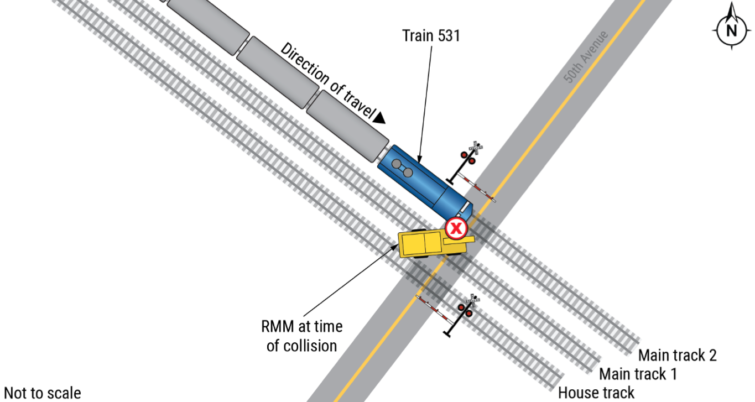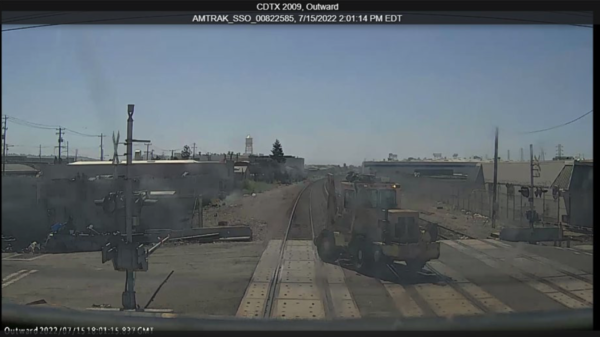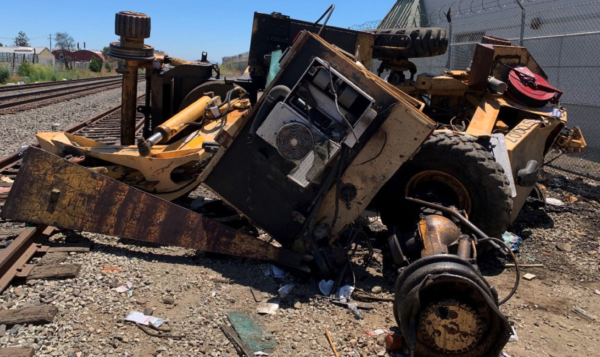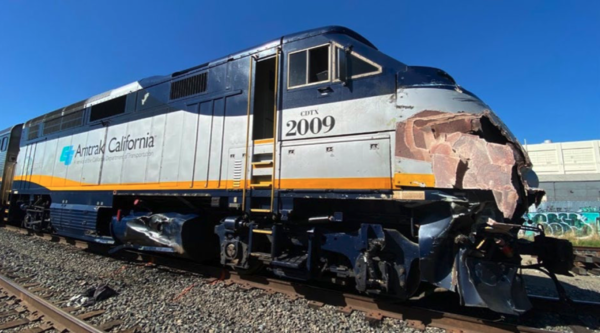NTSB Railroad Investigation Report: Amtrak Train 531 and UP RMM Collision
Written by Jennifer McLawhorn, Managing Editor
OAKLAND, Calif. – The NTSB released a Railroad Investigation Report after a collision between Amtrak train 531 and a Union Pacific Roadway Maintenance Machine in July of last year.
In July 2022, Amtrak train 531 (a train with one head-end locomotive, four coach cars, and one car car) collided with a Union Pacific speed swing roadway maintenance machine (RMM) at crossing DOR 749716B in Oakland, California on its way to San Jose. Now, the NTSB has released a Railroad Investigation Report (RIR-23-11). The report shows the RMM, a piece of equipment used to lift and move material, was occupied at the time of the collision, and the worker suffered severe injuries. A passenger and two train crewmembers aboard the Amtrak train had minor injuries.
According to the report, “the collision occurred as the RMM moved from main track 1 across main track 2, which was occupied by train 531,” as shown in the photo above. The equipment damage is estimated to be $92,000 and $216,000 for Amtrak and UP, respectively. The RMM “was a Speed Swing Model No. 445E manufactured by Pettibone and owned and operated by UP as speed-swing No. SS007; it was a hi-rail vehicle capable of operating over highways and railroad tracks.” In July 2022, the RMM was used by a group assigned to the Alameda County Regional Auto Theft Task Force, and a “single operator was on board. . . Two other UP personnel, a roadway worker-in-charge (RWIC) and a backhoe operator, were also part of the roadway work group.”
The track near the collision was owned by Union Pacific, and the maximum speed for passenger trains in that area was 79 miles per hour. The Class 1 “authorized train movements through the area with a traffic control signal system, [and] Train movements were coordinated by a UP dispatcher at the UP dispatch center in Omaha, Nebraska.” At the time of the collision, the track was equipped with a PTC system which was “enabled and operating at the time of the collision.”
The crossing was “active” in that it had active warning devices to indicate an oncoming train. The warning devices “consisted of two sets of mast-mounted flashing lamps and two gates (one gate and set of lamps for each direction of highway approach).”

An interview with an engineer showed that the Amtrak train was ¾ mile away from said crossing on main track 2, and the engineer “observed the RMM on main track 1.” According to the report, “the engineer said that the RMM appeared to be stopped and that he commonly saw equipment stopped on adjascent tracks. According to the event recorder data, the engineer began a horn sequence at 11:01:02 a.m. while about 1,440 feet from the crossing and traveling at 73 mph.” A review of the electronic crossing records revealed that the RMM operator had “already lifted the RMM’s rail gear wheels.” Also, data from the “locomotive’s forward-facing image recorder showed the RMM stationary on main track 1; the RMM was facing away from the train with its wheels parallel to the track.” In the same minute, the RMM moved and began to turn toward main track 2. The locomotive’s forward-facing image recorder show that the crossing gates were down with lamps flashing.
After the last part of the horn sequence and an emergency brake attempt, the “train struck the RMM at 11:01:16 a.m. at 68 mph and continued moving through the crossing.” The engineer reported that the impact moved the locomotive and prevented him from moving the brake handle to the emergency position right away. The emergency brake application began at 11:01:19 a.m., and the “train stopped with its head end about 1,600 feet past the crossing.” Emergency responders showed up about 5 minutes after.
The photos below show the damage to both the RMM and Amtrak train 531 after the collision.


Under Section 1.3 Postcollision Inspections, the NTSB details its (and the FRA’s) inspections of the crossing’s warning system as well as test of train 531’s air brakes, locomotive’s horn, bell, and headlights. The inspections showed that there were no identifiable problems to the system’s operation at the crossing, and the train’s systems were not damaged too severely “to prevent testing functioned as designed.”
The analysis of NTSB’s RIR shows the RMM operator did not have knowledge of the approaching train, as evidenced by toxicology testing. Moreover, the “most recent training received by the RMM operator did not specifically address safe operation of RMMs over track at highway-railroad grade crossings, and the RMM operator’s decision to cross main track 2 despite the sounding of the locomotive’s horn and a clear line of sight to the approach train suggests that the RMM operator did not look or listen for trains before moving the RMM off protected track.”
As a result, Union Pacific has revised its RMM operator training to “include instructions for how to exit highway-railroad grade crossings safely when warning devices are activated or not present.” The training will also instruct operators to exit the crossing “without fouling adjacent track when possible and, when fouling a track is unavoidable, to turn off audible distractions such as AM/FM radios, roll down a window to listen for trains or other equipment, and proceed only after confirming that there is enough sight distance to complete the movement safely.”
In determining probable cause of the collision, the NTSB reported that the collision between the UP RMM and Amtrak train 531 was “the roadway maintenance machine operator moving for unknown reasons onto unprotected track and into the path of an approaching train.”
The National Transportation Safety Board Railroad Investigation Report can be read in its entirety here.





